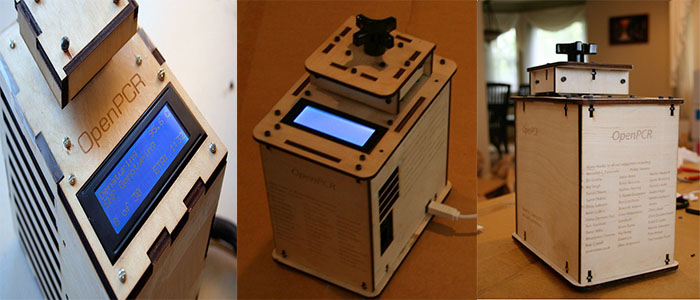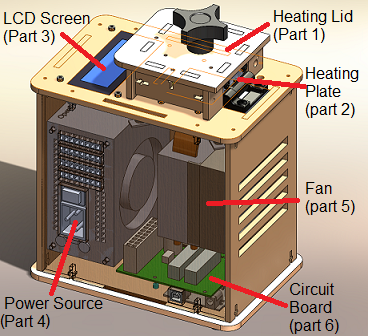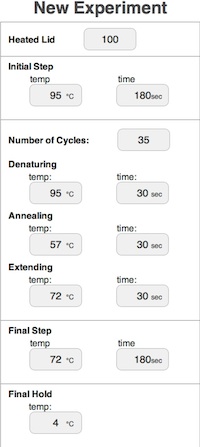BME100 f2013:W1200 Group4 L4
| Home People Lab Write-Up 1 | Lab Write-Up 2 | Lab Write-Up 3 Lab Write-Up 4 | Lab Write-Up 5 | Lab Write-Up 6 Course Logistics For Instructors Photos Wiki Editing Help | |||||||||
|
OUR TEAMLAB 1 WRITE-UPInitial Machine TestingThe Original Design The image above displays multiple viewing angles of OpenPCR. The original images of OpenPCR were obtained from multiple websites. Their citations are bellow. Cheap PCR. Digital image. BioTechniques. N.p., n.d. Web. 23 Oct. 2013. <http://www.biotechniques.com/news/biotechniquesNews/biotechniques-301745.html>. OpenPCR Ships worldwide. Digital image. MAKE. N.p., n.d. Web. 23 Oct. 2013. <http://makezine.com/2011/07/06/dna-is-now-diy-openpcr-ships-worldwide/>. OpenPCR. Digital image. Ponko.com. N.p., n.d. Web. 23 Oct. 2013. <http://blog.ponoko.com/2011/07/09/open-pcr-—-an-open-source-diy-dna-kit-you-can-buy/>.
There were six different parts of the OpenPCR machine that we looked at when we disassembled it. This included the heating lid (part 1), the heating plate (part 2), the LCD screen (part 3), the power supply (part 4), the fan (part 5), and the circuit board (part 6). If all of the parts and connections are not working properly, then the machine as a whole will not work. If the heating lid (part 1) did not work, the machine would not be able to maintain a specific heat, because it would be affected by the surrounding environment. If the heating plate (part 2) did not work, then the machine would not be able to control the temperature of the PCR tubes. If the power supply (part 4) did not work, then the machine as a whole would not be able to work. When we unplugged the LCD screen (part 3) from the circuit board (part 6), the machine no longer displayed any data on the LCD screen. When we unplugged the white wire that connects the circuit board (part 6) to the heating plate (part 2), the machine displayed a false reading of the temperature. It dropped from 27.8 degrees Celsius to -40.0 degrees Celsius.
A test run was conducted at 12:55 PM on Wednesday October 23, 2013. The machine ran properly and at a good rate. By 1:55 PM, the OpenPCR had performed approximately 16 cycles. Ultimately, the machine passed the test run.
ProtocolsFirst Step: 95[math]\displaystyle{ ^o }[/math]C for 180 seconds Second Step: 35 cycles of denaturing,annealing, and extending (in that respected order). Denaturing: 95[math]\displaystyle{ ^o }[/math]C for 30 seconds Annealing: 57[math]\displaystyle{ ^o }[/math]C for 30 seconds Extending: 72[math]\displaystyle{ ^o }[/math]C for 30 seconds Last Step: 72[math]\displaystyle{ ^o }[/math]C for 180 seconds Hold: 4[math]\displaystyle{ ^o }[/math]C DNA Sample: 50 μL each. Patient ID's from the UnderGrad Teaching Assistant(UGTA) DNA Sample Set-up
Research and DevelopmentPCR - The Underlying Technology The Polymerase Chain Reaction (PCR) is a method of replicating strands of DNA. Using this relatively simple procedure, it is possible to copy, or "amplify", billions of copies of the DNA of interest so they can be used in a variety of applications, from detecting viral infections to manipulating DNA in genetic engineering or synthetic biology. Components of a PCR Reaction The process begins with the template DNA, the target DNA strand that is being copied. Primers are short, laboratory-made pieces of DNA that are designed to match to the segment of target DNA. One primer attached to the top strand at one end of the segment of interest, and the other primer attaches to the bottom strand at the other end. Another component of a PCR reaction is magnesium chloride. This introduces magnesium into the reaction, which activates the DNA polymerase and causes it to begin working. function of the taq DNA polymerase is to make copies of a cell's DNA before it divides in two. When the DNA polymerase encounters a primer that is paired with a longer piece of DNA, it attaches itself to the end of the primer and begins to add deoxyribonucleotides (dNTPs). Nucleotides are the building blocks DNA are made of. The DNA grabs nucleotides that are floating in the liquid around it and attaches them to the end of the primer, effectively doubling the pre-existing DNA strands. The Steps of Thermal Cycling Each step of the polymerase chain reaction is activated by a certain temperature. A PCR machine performs thermal cycling to raise and lower the temperature at the required times for the reactions to occur. For the first three minutes of the process, the tubes containing the components are heated to 95 degrees Celsius. At this temperature, the DNA double helix spends thirty seconds separating, creating two single-stranded DNA molecules, in a step called denaturing. At 57 degrees Celsius, the primers anneal for thirty seconds, pairing up with the targeted DNA strands. The extending stage occurs at 72 degrees Celsius and lasts for thirty seconds. When the DNA polymerase locates a primer attached to a single DNA strand, it adds complementary nucleotides onto the strand. The tubes are maintained at 72 degrees Celsius for three additional minutes to ensure all strands have completed the process. During the final hold, the temperature is lowered to four degrees Celsius, limiting the activity of DNA polymerase and basically freezing it for later study. Nucleotides DNA is composed of four types of molecules called nucleotides: adenine (A), thymine (T), guanine (G), and cytosine (C). These pair up through hydrogen bonding forming the "rungs" of DNA's double-helix "ladder". Certain bases always pair up with each other. For example, adenine and thymine always pair, and guanine and cytosine always pair. Although the base pairings are limited, the order possibilities of the bases are endless, and this is what creates the DNA code that determines every aspect of life.
| |||||||||








